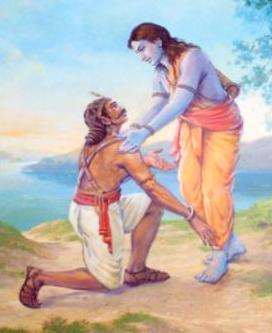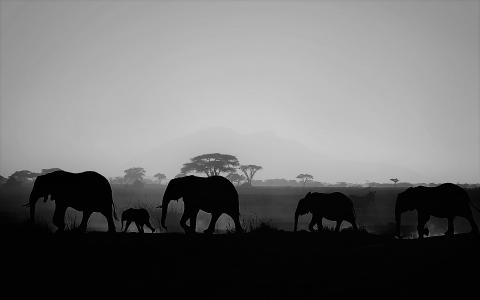June 2023

The next morning, Rāma awoke Lakṣmaṇa and they set out into the forest. Rāma enjoyed the beauty of nature and pointed it out to Sītā as well. Spellbound with the flora and fauna in and around the Citrakūṭa Mountain, Rāma decided that they should reside there. Upon Rāma’s instruction, Lakṣmaṇa built a parṇa-śālā – leaf-hut and then killed a black antelope to perform bali as a part of the housewarming ritual. Enjoying the beauty of the mountain...

230. Vṛddhakumārīvākya-nyāya
An old unmarried woman is called vṛddhakumārī. In the treatise, mahābhāṣya we find this nyāya described. Devendra, the king of deities appeared before one such old unmarried woman and told her that he is pleased and is willing to bestow upon her a vara. She asked him a vara as follows: “My kids should always be able to partake as much milk and ghee as they want in their diet and they should be able to consume them in...

We saw in the previous Bhāgavata śloka a mention of two birds in the primordial tree - dvikhago hyādivṛkṣaḥ. When there is a tree, there is usually a bird in it. The metaphor of the two birds comes to us again from the Veda. The Muṇḍakopaniṣad describes the two birds of the saṃsāra tree thus.
dvā suparṇā sayujā sakhāyā samānaṃ vṛkṣaṃ pariṣasvajāte ||
Muṇḍakopaniṣad 3.1.1
The mention of these two birds is seen elsewhere in the Vedas as well....

ಪ್ರತಿಕೃತಿ, ಪ್ರತಿಮಾ
ಸಾಹಿತ್ಯವೇ ಮೊದಲಾದ ಸಕಲ ಕಲೆಗಳಲ್ಲಿ ಸತ್ಯವು ಮೈದೋರುವ ಎರಡು ವಿಧಾನಗಳನ್ನು ಪುಟ್ಟಪ್ಪನವರು ಪ್ರತಿಕೃತಿ ಮತ್ತು ಪ್ರತಿಮಾ ಎಂದು ಹೆಸರಿಸಿದ್ದಾರೆ. ಅವರ ಪ್ರಕಾರ “ಇದ್ದುದನ್ನು ಇದ್ದಂತೆಯೆ, ನಡೆದುದನ್ನು ನಡೆದಂತೆಯೆ ಚಿತ್ರಿಸಲು ಪ್ರಯತ್ನಿಸುತ್ತದೆ ಪ್ರತಿಕೃತಿವಿಧಾನ ... ಇದ್ದುದನ್ನು ಇದ್ದಂತೆಯೆ, ನಡೆದುದನ್ನು ನಡೆದಂತೆಯೆ ಚಿತ್ರಿಸಬೇಕು ಎಂಬ ಪ್ರಯತ್ನಕ್ಕೆ ಹೋಗದೆ, ಇದ್ದದ್ದೂ ನಡೆದದ್ದೂ ತನಗೆ ಹೇಗೆ ಗೋಚರಿಸಿತೋ ಆ ಅನುಭವಕ್ಕೆ ಆಕಾರಕಲ್ಪನೆ ಮಾಡುವ ಪ್ರಯತ್ನದ ರೀತಿಯನ್ನು ಪ್ರತಿಮಾವಿಧಾನ ಎಂದು ಕರೆಯುತ್ತೇವೆ ... ಪ್ರತಿಕೃತಿಯ...

As long as the dust raised by Rāma’s chariot was visible, Daśaratha’s height appeared to be increasing, as he strained to catch a last glimpse of his son. He collapsed on the ground when Rāma was no longer visible. The queens Kausalyā and Kaikeyī escorted him to the palace. Daśaratha admonished Kaikeyī, “Don’t touch me! You are neither my queen nor my kin. You are only after wealth! I will soon renounce my life. If Bharata is happy to procure...

217. Rāsabharaṭita-nyāya
Rāsabharaṭita means the braying of the donkey. The donkey starts on a high decibel. But it keeps diminishing. On the surface if something looks profound but upon a careful second viewing looks trivial, to describe such a thing, this nyāya is used.
218. Rekhāgavaya-nyāya
Gavaya is something which resembles cattle; say a female bison. Someone seeing a drawing might think that it is a cow. Once he sees the real cow he...

What is the reason behind the name aśvattha for a tree thus extolled in the Veda? Śvaḥ in Saṃskṛt means tomorrow. Śvastha is something that will exist tomorrow just as it exists today. Aśvattha then refers to something that will not be the same tomorrow as it is today. It is something that changes every instant - something constantly changing or fickle.
na śvo’pi sthātā iti aśvatthaḥ taṃ kṣaṇapradhvaṃsinam aśvattham
(As it will not exist...

ಭಾವ, ರಸ
ಭಾವವನ್ನು ಕಾವ್ಯದ ಮೂಲವೆಂದು ಗಣಿಸುವ ಕುವೆಂಪು ಅದನ್ನು ಐದು ತಲೆಕಟ್ಟುಗಳಲ್ಲಿ ಗಮನಿಸಬೇಕೆನ್ನುತ್ತಾರೆ. ಅವು: (೧) ಔಚಿತ್ಯ, (೨) ಸ್ಫುಟತ್ವ, (೩) ಸ್ಥಾಯಿತ್ವ, (೪) ವೈವಿಧ್ಯ ಮತ್ತು (೫) ಮಹತ್ತ್ವ.[1] ಇವು ಒಳ್ಳೆಯ ಅಳತೆಗೋಲುಗಳೆಂದು ಎಲ್ಲರೂ ಒಪ್ಪಬಹುದು. ಒಂದೊಂದು ಅಂಶವನ್ನೂ ಪುಟ್ಟಪ್ಪನವರು ದೀರ್ಘವಾಗಿ, ಸೋದಾಹರಣವಾಗಿ ವಿವರಿಸಿದ್ದಾರೆ. ಆ ಪ್ರಕಾರ “ಲೇಖಕ ತನ್ನ ಸನ್ನಿವೇಶ, ಸಮಾಜ, ಮನಃಪರಿಸ್ಥಿತಿಗಳಿಗೆ ಸಮರೂಪವಾಗಿ, ಸಂವಾದಿಯಾಗಿ ತನ್ನ ಭಾವವನ್ನು ತಂದಿದ್ದಾನೆಯೆ” ಎಂದು ಪರೀಕ್ಷಿಸುವುದು ಔಚಿತ್ಯದ ತೆಕ್ಕೆಗೆ ಬರುತ್ತದೆ. “ಸ್ಫುಟತ್ವ...

A brāhmaṇa by name Trijaṭa who belonged to the Gārgya-gotra approached Rāma and told him about his poverty. He had many children and subsisted his family through uñcha-vṛtti. He requested Rāma for help. Rāma promised him, “I have not given away even a thousand cows. Throw your staff to a distance. You will get as many cows as covered by your staff.” Excited, Trijaṭa tied his upper garment to his waist, whirled his stick above his head, and flung...

207. Yat karabhasya pṛṣṭhe na māti tat kaṇṭhe nibadhyate
The master fastens an unbearable load around the camel’s neck! Camels are known to bear huge loads. When there is already a humongous load on its back, if something is fastened around its neck, imagine the plight. When one goes through unbearable difficulties, this is used to describe their fate. This can also be applied when something which is unbearable to a strong man is thrust upon a...
